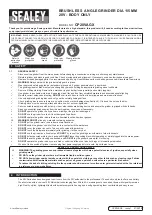
EN
101
materials.
p)
Do not use accessories that require
liquid coolants.
Using water or other liq-
uid coolants may result in electrocution or
shock.
KICKBACK AND RELATED WARNINGS
Kickback is a sudden reaction to a pinched or
snagged rotating wheel or any other accesso-
ry. Pinching or snagging causes rapid stalling
of the rotating accessory which in turn causes
the uncontrolled power tool to be forced in the
direction opposite of the accessory’s rotation
at the point of the binding.
For example, if an abrasive wheel is snagged
or pinched by the workpiece, the edge of the
wheel that is entering into the pinch point can
dig into the surface of the material causing the
wheel to climb out or kick out. The wheel may
either jump toward or away from the operator,
depending on direction of the wheel’s move-
ment at the point of pinching. Abrasive wheels
may also break under these conditions.
Kickback is the result of power tool misuse
and/or incorrect operating procedures or con-
ditions and can be avoided by taking proper
precautions as given below.
a)
Maintain a firm grip on the power tool
and position your body and arm to al-
low you to resist kickback forces. Al-
ways use auxiliary handle, if provided,
for maximum control over kickback
or torque reaction during start-up.
The
operator can control torque reactions or
kickback forces, if proper precautions are
taken.
b)
Never place your hand near the rotating
accessory.
Accessory may kickback over
your hand.
c)
Do not position your body in the area
where power tool will move if kickback
occurs.
Kickback will propel the tool in di-
rection opposite to the wheel’s movement at
the point of snagging.
d)
Use special care when working corners,
sharp edges etc. Avoid bouncing and
snagging the accessory.
Corners, sharp
edges or bouncing have a tendency to snag
the rotating accessory and cause loss of
control or kickback.
e)
Do not attach a saw chain woodcarving
blade or toothed saw blade.
Such blades
create frequent kickback and loss of con-
trol.
SAFETY WARNINGS SPECIFIC FOR GRIND-
ING AND ABRASIVE CUTTING-OFF OPERA-
TIONS:
a)
Use only wheel types that are recom-
mended for your power tool and the
specific guard designed for the selected
wheel.
Wheels for which the power tool
was not designed cannot be adequately
guarded and are unsafe.
b)
The guard must be securely attached
to the power tool and positioned for
maximum safety, so the least amount
of wheel is exposed towards the opera-
tor.
The guard helps to protect the operator
from broken wheel fragments, accidental
contact with wheel and sparks that could
ignite clothing.
c)
Wheels must be used only for recom-
mended applications. For example: do
not grind with the side of cut-off wheel.
Abrasive cut-off wheels are intended for
peripheral grinding, side forces applied to
these wheels may cause them to shatter.
d)
Always use undamaged wheel flanges
that are of correct size and shape for
your selected wheel.
Proper wheel flanges
support the wheel thus reducing the pos-
sibility of wheel breakage. Flanges for cut-
off wheels may be different from grinding
wheel flanges.
e)
Do not use worn down wheels from larg-
er power tools.
Wheel intended for larger
power tool is not suitable for the higher
speed of a smaller tool and may burst.
Summary of Contents for PE-2350WS
Page 14: ...DE 12...
Page 26: ...FR 24...
Page 38: ...IT 36...
Page 50: ...NL 48...
Page 62: ...SV 60...
Page 74: ...CZ 72...
Page 86: ...SK 84...
Page 98: ...RO 96...
Page 110: ...EN 108...








































